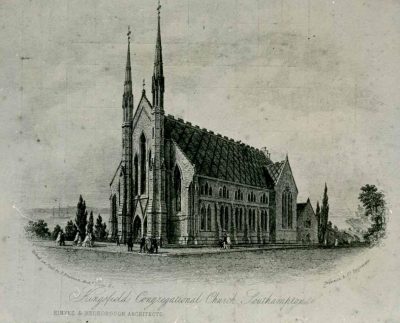Kingsfield Congregational Church
Kingsfield Congregational Church was formed in 1853, by members of Albion Chapel. Rev. Joseph Wyld, the minister of Albion, was not acceptable to all of Albion’s members, and he was not happy with the Albion congregation, and so he left, with some of the members, to form a new congregation. The Southampton City archive holds the document signed by the 42 members who broke away, in which they state their reasons for leaving. At first they held services in the Royal Victoria Rooms, calling themselves The Third Congregational Church. Wyld remained the pastor for seventeen months, before retiring from pastoral care, before re-joining the established church as a priest. His nonconformist flock had to decide whether to continue as a separate congregation, or to re-join one of the other two Congregational Churches in the town. They decided to form their own church, with Rev Peter Turner from St. Neots to lead them. A plot of land in Havelock Road, on the Kingsfield Estate, became available, and so the congregation built their own church, calling it the Kingsfield Congregational Church. The foundation stone was laid in October 1860, and the building was opened in November 1861, at a total cost of £2370. The church was situated in what was then the southern part of Havelock Road, in the West Marlands area of the city. It is thought that the Skandia House office block now occupies the site. Others think it was on the site of the present Civic Centre car park. The church was designed by local architects William Hinves and Alfred Bedborough in the flamboyant Early Decorated Gothic style, with twin spires nearly 90 foot high, and was built by Alfred Watts of Freemantle. On completion The Hampshire Independent thought it the “prettiest chapel in the neighbourhood”. There were two aisles, and three blocks of seating. The eighteen rows had six seats in each of the side blocks, and fourteen in the centre block. It could seat 600 downstairs and a further 250 in the side galleries, which was accessed by two stairways on either side of the vestibule. During the building of the church the minister died in July 1861, and was succeeded by Rev John Hill M.A., who remained there until 1864. Rev Thomas Sissons followed him, and under his leadership the membership greatly increased. A schoolroom was constructed and £300 of the mortgage was paid off. Hill’s health failed and he left in August 1867. The following January Rev R G Harper came, and stayed until March 1870, when he left to form the theologically far broader Windsor Church, meeting in the Philharmonic Hall. Having had 5 ministers, each with very short tenure, the church elected a young man straight from Cheshunt College. Rev S. B. Stribling came for fourteen years until December 1884. He oversaw all the debt clearances, including £1000 mortgage, and other liabilities. Rev T. W. Cheeseman was the next minister, from 1885 until 1859, when he left for Andover, and later the Episcopal Church in America. He was followed by Vincett Cook (1890-1904), who left to become minister at Bitterne Congregational Church. Under his leadership largescale renovations were carried out, and classrooms and other accommodation were built. Robert Ashenhurst (1905-1910) oversaw the completion of the classroom at a cost of over £500. Peter Buchan (1912-1917) was the final ordained clergyman. After he left for Bolton, Mr Walter C Green was an honorary pastor for nearly two years, but gave up due to ill health. At the beginning of the twentieth century, the congregation started to decline. In 1901 there were 111 members, but by 1914 there were only 92. The year book of 1915 shows that services were held at 11 and 6.30 on Sunday, and 7.45 on Thursday evenings. Sunday school classes were held on a Sunday at 10, 2.30 and 2.50. There was a Guild, a working society, a junior society of Christian Endeavour, a bible class, a Children’s Hour, a Junior Guild, and a choir, which met for practice on Friday evenings. The membership went into further decline, because the character of the neighbourhood changed considerably. People were living further away from the centre of the town. Losses by death and removal were not being replaced in what had become a “down town” church. Discussions started about discontinuing. On 6th April 1919 the last communion service was held, and was conducted by Rev H T Spencer of Avenue Congregational Church, and the closing service was held on 13th April 1919, conducted by Mr William Dale, one of Southampton’s best lay preachers. The church was formally dissolved on 31st July 1919 with the trustees winding it up. The decorative church spires were removed, and in October 1919 the building became a labour exchange. The trustees of the church legally conveyed the property to them at the end of January 1922.The proceeds from the sale went to fund Congregational work elsewhere. The building was demolished in 1936.
Ministers of Kinsgfield Congregational Church
1853-1855 Rev. Joseph Wyld
1856-July 1861 Rev. Peter Turner
1861-1864 Rev. John Hill M.A.
1865-August 1867 Rev. Thomas Sissons
January 1868-March 1870 Rev. R G Harper
July 1870-December 1884 Rev. Samuel B. Stribling
1885-1889 Rev. T.W.Cheeseman
1890-1904 Rev. Vincett Cook
1905-1910 Rev. Robert Ashenhurst
1912-1917 Rev. Peter Buchan
1917-1919 honorary pastor Mr Walter C. Green

